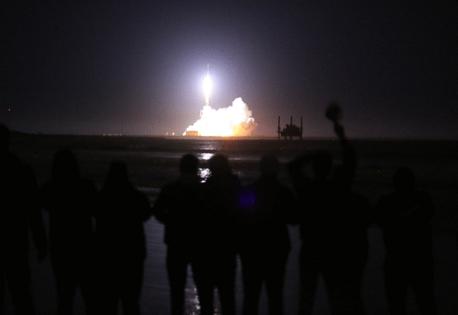FAA closes investigation into Blue Origin New Glenn booster failure
Published in Science & Technology News
The Federal Aviation Administration said Monday that it will allow Blue Origin’s New Glenn rocket to fly again, following a review of the January mishap in which the rocket made a successful debut launch but crashed during landing.
As is standard in such events, the FAA had grounded the rocket immediately after the accident while the Jeff Bezos-owned company investigated.
“The final mishap report identified the proximate cause of the mishap as an inability of New Glenn’s first stage to restart the engines, preventing a reentry burn from occurring, and resulting in the loss of the stage,” the FAA stated in a press release.
New Glenn launched Jan. 16 on the NG-1 mission from Cape Canaveral Space Force Station’s Launch Complex 36 carrying a payload to orbit. Similar to how SpaceX Falcon 9 rocket first stages land on droneships stationed in the Atlantic, Blue Origin’s heavy-lift rocket is designed to be reused.
However, the first stage, which was named “So You’re Telling Me There’s a Chance,” didn’t make it to Blue Origin’s landing ship, with the booster debris falling into the ocean.
“Our review confirmed that all debris landed in our designated hazard area with no threat to public safety,” Blue Origin said in a statement.
The investigation found seven corrective actions to be taken before another New Glenn launches.
“We expect to return to flight in late spring and will attempt to land the booster again,” Blue Origin stated.
The FAA indicated it would verify the corrective actions are taken before the NG-2 mission takes flight, but said the rocket is cleared to fly again.
Bezos has been trying to join competitors SpaceX and United Launch Alliance with its powerful rocket. While it took years to make its debut flight, New Glenn made history becoming the first rocket from a commercial company to reach orbit on the initial try.
Companies like SpaceX, Rocket Lab, Virgin Orbit, Astra Space and Relativity Space all failed in that endeavor.
The mission acted as one of two required flights to gain Space Force certification that would open up New Glenn as an option to fly national security missions for the Department of Defense.
The company also has several commercial customers on tap, including Bezos’ old company Amazon, which has contracted for at least 12 launches to send up hundreds of satellites for its Project Kuiper internet constellation, an effort to compete with SpaceX’s Starlink.
New Glenn is also tapped by NASA to fly a pair of Mars-bound satellites and will be the launch rocket for Blue Origin’s Blue Moon lunar landers, one of which is contracted as the human landing system for the Artemis V mission no earlier than 2029.
Bezos has sunk billions into the company, which had previously launched only its suborbital New Shepard rockets from its West Texas launch site.
Blue Origin took over the lease for LC-36 in 2015, investing about $1 billion in the pad site alone. It was previously used for government launches from 1962-2005, including lunar lander Surveyor 1 in 1967 and some of the Mariner probes.
_____
©2025 Orlando Sentinel. Visit orlandosentinel.com. Distributed by Tribune Content Agency, LLC.







Comments